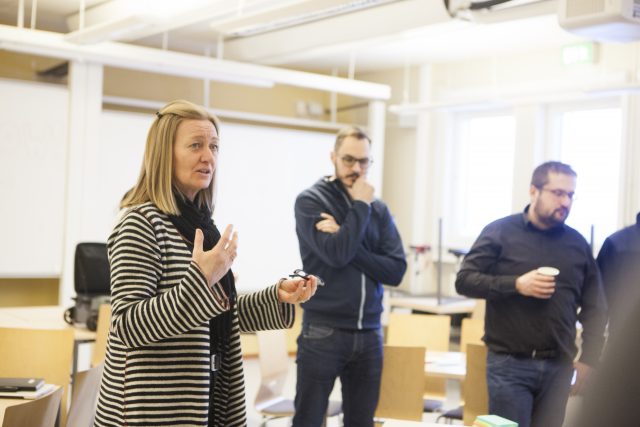On the day after the now iconic launch of the Falcon Heavy Rocket at Cape Canaveral, the space industry in Kiruna met to form a joint strategy to meet this new space paradigm.
– This meeting was important. To strengthen the regional space business we need to collaborate more in a structured way, said Johanna Bergström-Roos from LTU Business, and project manager for the RIT-project. Today we took an import step to establish our co-creation further, something that we have been working hard with within the RIT project.
Twenty participants from IRF, EISCAT, SSC, Luleå University of Technology and LTU Business took part in the workshop, initiated by SSC and the RIT project. The purpose was to discover common denominators and strategic areas of cooperation with the goal to create a concrete list of areas where the partners work together.
Areas of particular importance was identified such as discovering new research topics and innovations, R&D collaboration between organizations, how to meet the new space paradigm and how to keep and attract relevant competence and investors to northern Sweden.
The Swedish Space Corporation is currently aiming to launch small satellites, so called cubesats, from Esrange Space Centre starting 2021. They are presently in negotiations with politicians and authorities to create the right practical and economical conditions.
– With this in mind, it is our long-term plan to build up our competence in the region and one of our biggest challenges is to keep our specialists and to use them in the right fields where all organizations can benefit together, said Philip Påhlsson, project manager for New Esrange SSC.
The Institute of Space Physics, IRF, was also present to discuss their needs and role in the fast-growing space economy.
– We need a common strategy so we can work toward the same goals. We also need a plan on how to use disruptive technology and prepare for the future. On an operational level we need funding for additional infrastructure so that we can start building for the future today, said Ella Carlsson Sjöberg, deputy director at IRF.
EISCAT who just landed their new 700 million SEK research project, EISCAT 3D, was on the same page.
– We are jubilant and at the same time terrified how we will manage a project of this size. And we have realized that we can’t do it alone. We must strengthen the ties to our partners in the region particularly SSC and LTU where we have seen a big overlap in scientific output over the years. We have had projects together but mostly on an individual level. We now recognize that these need to be strategic collaborations on an organizational level, said Craig Heinselman, Director at EISCAT Scientific Association.
Luleå University of Technology was also present representing several fields of space related research. With the outspoken goal to become the leading Swedish space university they were also excited to participate in a consensus innovation workshop.
– I think this is the first time that we’ve gathered this many organizations and research subjects in one room to discuss common R&D space projects, and it feels great. I can already see how much in common we have with the others and I have big expectations on the results of this workshop and our coming projects, said Marta-Lena Antti, Chaired Professor in Engineering Materials at Luleå University of Technology.
